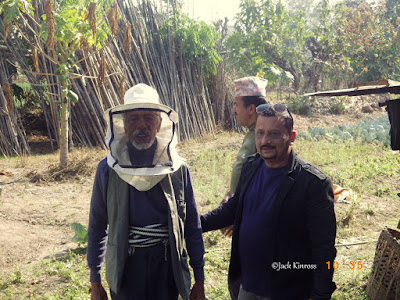Below are two posts made at Facebook (if you wish to comment) over the last couple of days
#HumanWildlifeConflict MITIGATION - BIOLOGICAL FENCE... Right this minute Hemanta is managing the Rapid Response Team and Cbapu Bardia members as the first biological fence using bees to ward off elephants is being developed. Elephants come right into our living area you can see in the image. Today the bee hives are being hoisted and the model developed at one of the main elephant entry points (we call it the "Elephant Highway"), we'll explain the exact dynamics of how the fence works soon. The production of "Tiger Honey" as an income generator to help fund the RRT, CBAPU and the community beyond is an important component. People really give their time freely, many, many hours, something which I think is lost on the world at large when the difficulties in high conflict zones like this one are viewed.
Further to my post yesterday, later in the day a few kilometres away down at the Park HQ, preparations were being made for a community health camp. 35 doctors will be in attendance today so that many people who could not otherwise afford it, will have free health care. This is one of the things I love about Bardia, the efforts made for community engagement. Congratulations to all stakeholders involved, I'll post some images of today's event. I'm not sure if it's just my black humour but the fact that some of the treatment tents are next to the crocodile breeding centre made me think, except I don't really know what to think...
The image where you can see the blue tarpaulin is where a juvenile female leopard is now in isolation, the first phase of rehabilitation. I've mentioned this briefly before, there will be updates when appropriate but this will be a really challenging rehab. The cub is much older than in the situation where we've posted about infant leopard cubs which have been eventually rewilded. This leopard is a highly aggressive juvenile which has been separated from her mother, obviously she cannot be handled and human contact has to be as close to zero as we can manage. I've called her Dipnani (pronounced Deepnaani) for reasons I'll explain later but there is a chipati connection which already a few will quickly understand.
We'll make every effort for Dipnani but the outcome is in the balance...
So this post is a situation of marginalized people and wildlife getting help. Many of you will know how there is a lot of controversy right now about "shoot to kill" orders on poachers, the increasing militarization of conservation. Communities are feeling more and more disenfranchised in many parts of the world and like the "war" on drugs it looks like the same mistakes are being made. Many of the decisions being made are by people a long way from the reality on the ground and public pressure from "laptop warriors" is also playing a part in this.
Community engagement, support for locals, understanding of people "living with leopards" (to use the metaphor) is vital in the long run. Personally I am very unhappy with some of these developments and will be voicing further.
Sanctity of life is sanctity of life, the true conservationist does not discriminate, there has to a sensitivity that every one is precious. Some of the decisions that have to be made for the big picture are hard enough anyway... all the more reason why these decisions need to be made by the right people...
The image where you can see the blue tarpaulin is where a juvenile female leopard is now in isolation, the first phase of rehabilitation. I've mentioned this briefly before, there will be updates when appropriate but this will be a really challenging rehab. The cub is much older than in the situation where we've posted about infant leopard cubs which have been eventually rewilded. This leopard is a highly aggressive juvenile which has been separated from her mother, obviously she cannot be handled and human contact has to be as close to zero as we can manage. I've called her Dipnani (pronounced Deepnaani) for reasons I'll explain later but there is a chipati connection which already a few will quickly understand.
We'll make every effort for Dipnani but the outcome is in the balance...
So this post is a situation of marginalized people and wildlife getting help. Many of you will know how there is a lot of controversy right now about "shoot to kill" orders on poachers, the increasing militarization of conservation. Communities are feeling more and more disenfranchised in many parts of the world and like the "war" on drugs it looks like the same mistakes are being made. Many of the decisions being made are by people a long way from the reality on the ground and public pressure from "laptop warriors" is also playing a part in this.
Community engagement, support for locals, understanding of people "living with leopards" (to use the metaphor) is vital in the long run. Personally I am very unhappy with some of these developments and will be voicing further.
Sanctity of life is sanctity of life, the true conservationist does not discriminate, there has to a sensitivity that every one is precious. Some of the decisions that have to be made for the big picture are hard enough anyway... all the more reason why these decisions need to be made by the right people...





























